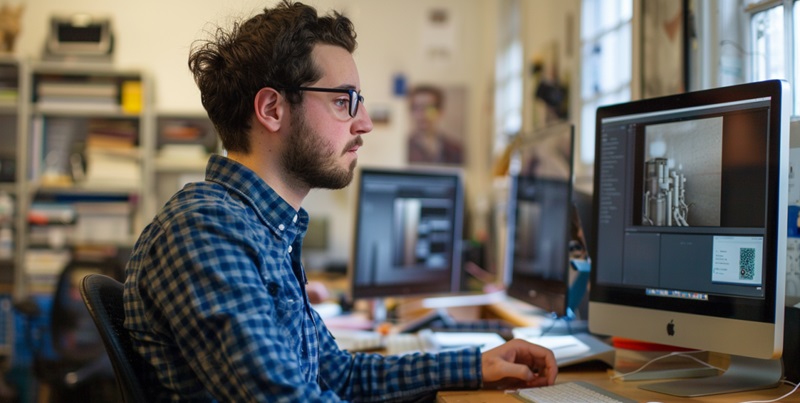In the dynamic and visually driven world of graphic design, where time is of the essence, designers are continually navigating the tension between creativity and efficiency. The meticulous and often laborious tasks of cropping, colour adjustments, and object removal could, in the era of traditional image editing, bog down even the most passionate artists. Given the relentless pace of project turnarounds and the high bar for excellence, it’s no wonder that designers have historically been mired in routines that, while necessary, could sap creativity and lead to burnout. Yet, the dawn of Artificial Intelligence (AI) in this creative domain has initiated a seminal shift, offering tools not only designed to speed up the workflow but also to reignite the creative flame that fuels the industry.
The Challenges of Traditional Image Editing
The old adage that ‘time is money’ couldn’t be truer in the field of graphic design. Traditional image editing software has been an invaluable tool for designers, yet these programs often require a painstaking commitment to detail that can be immensely time-consuming. With deadlines looming, designers were frequently caught in a vortex of repetitive tasks, from perfecting the hue of a sunset to delicately erasing unwanted elements. This could spell endless hours of refinements before reaching that elusive final draft.
The pressure is multifaceted; not only must designers be technically skilled with their toolsets, but they are also expected to push the boundaries of their creative visions. When consumed by the minutiae of image editing, the spark of ingenuity risks being extinguished under the weight of unrelenting demands and looming deadlines, ultimately stifling innovation and potentially compromising the designer’s work-life balance.
AI Innovations in Image Editing
Enter the age of AI, where the once monolithic landscape of graphic design is being reshaped by an infusion of intelligent technology. Programs like Adobe’s AI-driven Photoshop are employing sophisticated algorithms that can learn and improve over time, automating tasks that previously ate into a designer’s productive hours. Features such as automated image enhancement and object recognition epitomize how AI is enhancing workflows, slashing the time spent on tedious tasks.
AI is not just about saving time, it’s also about expanding creative possibilities. Tools like Luminar AI go further with innovative capabilities like sky replacement and advanced portrait editing, which were once areas of intense manual labor. Remove.bg’s background extraction technology exhibits AI’s precision and speed, trumping traditional methods to deliver flawless results in moments, transforming what once was a chore into a smooth, almost intuitive process.
Empowering Creativity and Productivity
Gone are the days when a substantial portion of a graphic designer’s workload was tethered to monotonous, time-consuming tasks. With AI’s entrance onto the creative stage, the routine has been overhauled, allowing professionals more room to breathe and innovate. It’s this shift away from the mundane that not only amplifies productivity but also enriches the very essence of creativity in the field.
Thanks to AI, designers can rapidly iterate and fine-tune their creations, which enables them to turn out more thoughtful, compelling, and sophisticated designs. With a newfound agility, they can effortlessly cycle through options, test new ideas, and deliver richer visual experiences, relegating the drudgery of the past to a faint memory.
Real-World Impact on Agencies and Freelancers
The effectiveness of AI in graphic design is not just theoretical, its benefits are palpable in the illustrated successes of both large marketing agencies and independent freelancers. Agencies like Splash Worldwide have experienced firsthand the acceleration of workflow and the leap in productivity that AI tools provide. The ability to edit large volumes of images quickly and professionally means that more time can be invested into strategic thinking and conceptual development, the true hallmarks of branding and campaign creation.
Freelancers, too, have found their professional horizons broadened by the advent of AI. Beyond streamlining their workflow, AI tools have augmented the quality and execution of their designs. Personal anecdotes from the freelance community reveal stories of transformations where work once mired in long hours is now realized in a fraction of the time, emancipating these creatives to invest more in honing their craft and their business.
The Future of Graphic Design with AI
The era of AI in graphic design is not on the distant horizon, it is here, marking a tectonic shift in how the industry operates. The gains in productivity and creativity afforded by AI tools are irrefutable, compelling even the most traditional designers to consider the possibilities. The future is bound to bring even more sophisticated AI applications, presenting both opportunities and challenges for adopting and mastering these technologies.
Staying competitive in this evolving landscape not only requires an openness to innovation but also a dedication to learning. With AI, the graphic design industry is poised for continued growth and expansion, promising an era where design is democratized and creativity knows no bounds. Designers who harness the power of AI are set to redefine what’s possible, delivering designs that are both strikingly original and executed with unfathomable speed.

